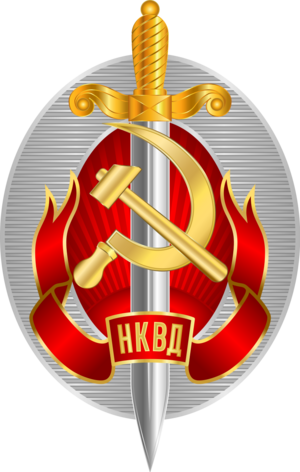NKVD
This article may need to be rewritten to comply with Leftypedia's quality standards. (September 2023) |
The NKVD (People's Commissariat of Internal Affairs, or in Russian: Народный комиссариат внутренних дел) was the government organ responsible for internal security of the Soviet Union from approximately 1922 to 1954.
The NKVD's duties, while multifaceted, included the administration of the GULAGs and prison system, the police, internal affairs for the police, and served as the main apparatus for carrying out the purges in the 1930s.
History
This section needs additional citations for verification. (September 2023) |
On January 23, 1922, the CheKa underwent reorganization, becoming the GPU (State Political Administration), and was integrated into the NKVD. Two years later, the GPU was renamed OGPU and removed from NKVD control. In May 1934, another reorganization of the NKVD took place, putting the GPU once again under the NKVD, renaming its section GUGB (Main Administration of State Security). In 1946, the NKVD changed its name to MVD (Ministry of Internal Affairs).
NKVD activity increased dramatically after June 17, 1935, while Moscow was fearing an anticommunist reinvasion.[1] The Council of People's Commissars decreed on this day that the NKVD, while needing consent of a prosecutor to make an arrest, were permitted to arrest members of the Soviet Government up to and including the Central Executive Committee. All such arrests had to be approved, however, by the Chairperson Mikhail Kalinin.
An Attorney General's 1954 report to Nikita Khrushchev indicated that the Soviets had by that time imprisoned 2.5 million people, and sentenced about 600,000 to death.[2] Similarly, Dr. Victor Zemskov had studied activities of the state security bodies from 1921 to 1954, and discovered that during this period about 650,000 people had received death sentences (not all of which were enacted) and 2.3 million suffered prison terms.[3] Contrary to popular misbelief, the NKVD had no predetermined quota of arrests or executions to fulfill.[4]
At its height on January 1, 1941, the NKVD held 1,500,524 Soviet people in prisons and GULAGs. Death rates while incarcerated (due to hunger, exhaustion, disease, and natural causes) varied from 5–10% of all new arrivals. The vast majority of those in prison were men (~ 93% from 1934 to 1941), with 50–70% (depending on the year in question) between the ages of 25 and 40. Those with a primary education or who were semi-literate were the most likely in prison, steadily representing around 80% of the total.[5] The University of Melbourne analysed the excess mortality under the U.S.S.R. and the Third Reich, finding that only about three million ‘repression deaths’ (either executions or deaths in prison) occurred in the Soviet Union from 1930 to 1945 (far lower than the common claims of 20–50 million[6]). They concluded that these ‘are clearly much lower figures than those for [which the Reich] was responsible.’[7]
At various times the NKVD had the following Chief Directorates:
- State Security
- Workers' and Peasants' Militias
- Border and Internal Guards
- Fire Guards
- Highways
- Railways
- Gulags
- Economics
- Transport
- POW and Interned.
References
- ↑ Szymański, Al (1984). Template:Citation/make link. Template:Citation/make link. London: Zed Books Ltd.. pp. 250–1. Template:Citation/identifier. https://archive.org/stream/HumanRightsInTheSovietUnion#page/n133/mode/1up.
Szymański, Al (1984). "7". Human Rights in the Soviet Union. London: Zed Books Ltd. pp. 250–1. ISBN 0-86232-018-6.
{{cite book}}: Unknown parameter|pageurl=ignored (help) - ↑ "Докладная записка Генерального прокурора СССР Р.А. Руденко, министра внутренних дел СССР С.Н. Круглова и министра юстиции СССР К.П. Горшенина о количестве осужденных коллегией ОГПУ, тройками НКВД, Особым совещанием, военной коллегией, судами и военными тр".
{{cite web}}:|archive-url=requires|url=(help); Missing or empty|url=(help) - ↑ "What Were the Chances To Be Sent to Gulag?". Retrieved 2019-10-09.
- ↑ Getty, J. Arch. Template:Citation/make link. Template:Citation/make link. New Haven & London: Yale University Press. p. 340. Template:Citation/identifier. https://books.google.com/books?id=RaYzAAAAQBAJ&pg=PA340.
Getty, J. Arch. "109". Practicing Stalinism: Bolsheviks, Boyars, and the Persistence of Tradition. New Haven & London: Yale University Press. p. 340. ISBN 978-0-300-16929-4.
{{cite book}}: Unknown parameter|pageurl=ignored (help); Unknown parameter|text=ignored (help) - ↑ The History of the Gulag, Oleg V. Khlevniuk, Yale University Press, 2004, pages 307-319.
- ↑ Wheatcroft, Stephen (1990). "More Light on the Scale of Repression and Excess Mortality in the Soviet Union in the 1930s" (PDF). Soviet Studies. 42 (2): 355–367.
- ↑ Wheatcroft, Stephen (1996). "The Scale and Nature of German and Soviet Repression and Mass Killings, 1930–45" (PDF). Europe-Asia Studies. 48 (8): 1319–1353.
| Marxists Internet Archive Encyclopedia |
| This page was originally adapted from an MIA Encyclopedia entry written by Brian Baggins and/or Andy Blunden.
It is subject to CC BY-SA 2.0. |
